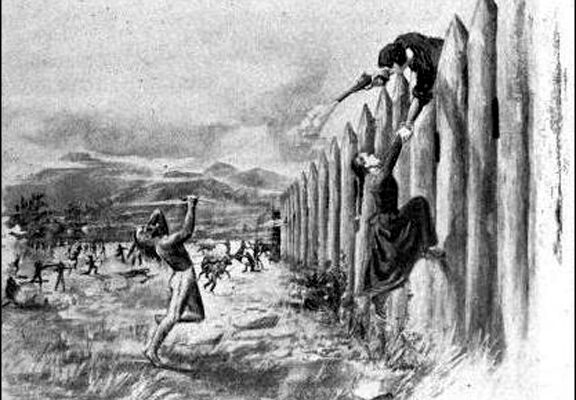According to the late T.C. Karns, University of Tennessee professor and a turn of the century writer of Tennessee history, had this to say about Catherine Sherrill (1755-1836) in 1904. “She, a daughter of one of the first settlers on the Watauga, was tall and slender with dark eyes and hair, clear skin and a neck that was said to be like that of a swan. She was strikingly beautiful as well as being one of the greatest and bravest girls in the settlement.”
The patriotic woman faithfully provided horses, wagons, provisions, and supplies for the army. According to a DAR linage book, she was born in North Carolina and died in Russellville, Alabama.
The wild ways of this new country seemed to suit her because she enjoyed the open life of the forest, even with its ever-present spice of danger from Indians and wild animals. Proof of her athletic abilities was that she could run like a deer and easily spring over a six-rail high fence by thrusting herself off the top one.
In 1776 when Catherine was about 20 years old, a party of Cherokee Indians attacked Fort Watauga in Carter County. Prior to this, Nancy Ward sent scouts to inform her friends that the Indians were coming. This prompted almost all of the settlers to gather inside the fort for safety.
However, early one morning, several women boldly left the security of the fort to milk some cows. Among them was Catherine Sherrill. All at once, the war whoop sounded and the women ran with all their might toward the fort. Catherine happened to be the furthest away and, although she darted forward with the speed of the wind, she noticed that the Indians had gotten precariously between her and the gate.

Catherine Sherrill's Escape from the Indians with Aid from Future Husband, John Sevier
John Sevier was in the fort and, seeing Catherine in great peril, rushed out of the gate with several other men to attempt to beat the Indians back and rescue their ladies. Knowing that Sevier could do nothing against 300 savages, his friends urged him back and began firing at the Indians from atop the fort wall.
It was a race for life and Catherine, seeing no other chance to make good her escape, turned and made her way to the other side of the fort. The wooden wall of the stockade was eight feet high, but with one mighty spring, Catherine reached the top and fell over into the arms of John Sevier. The other women also returned safely. The Indians, not prone to accept defeat, prolonged their attack for 20 additional days.
The settlers were safe behind their strong walls, but numerous of the Indians perished in the melee. Bullets rattled against the fort like hailstones but did no harm. Finally the Indians departed and returned to their homes on the Tellico River.
Four years later in 1780 and after Sevier's first wife had died, Catherine Sherrill became his second wife. The wedding took place at Sevier's new home on the Nolichucky River.
Throughout a long life, she was his faithful companion and helpmeet. But she and John never forgot the thrilling moment when she fell into his arms from the top of the fort and he called her for the first time his “Bonnie Kate.”
Mrs. Sevier often boasted that the first work she did after marriage was to spin, weave and make suits of clothes, which her husband and his three sons wore in the memorable battle of King's Mountain. She became the mother of eight children, three sons and five daughters.
John Sevier, hero of the American Revolution, whose life was one of romance, later died in Alabama. His remains were buried there for 73 years without a memorial stone to mark the place of his repose or an enclosure to guard against unhallowed intrusion.
In 1888, Sevier's body was removed by the State of Tennessee and laid to rest beneath the sod of the state he had loved and served so faithfully. He was buried in Knoxville, along with a stately monument as a memorial of the state's everlasting though tardy gratitude to her honored son. Later, Catherine's remains were appropriately displaced next to her husband.

Comments are closed.